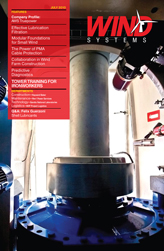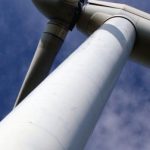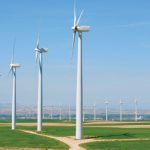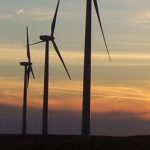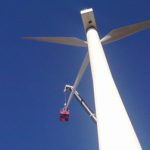As readers of this magazine undoubtedly know, renewable sources such as wind and solar currently supply less than 10 percent of the energy consumed in the United States. But what if the production of this renewable resource was more efficient, enabling companies to see improved results in the bottom line and help drive the usage of wind energy?
Increasing efficiency in the conversion, delivery, and utilization of energy is an essential part of a comprehensive national energy policy. It would only make sense that alternative energy resources such as wind turbines utilize highly efficient generators or motors to create the power to the grids. The Energy Independence and Securities Act goes into effect in less than one year and specifically addresses raising the efficiency levels of industrial electric motors. A few startling statistics:
• An electric motor consumes approximately 65 percent of generated electrical energy;
• The cost of operating an electric motor can run up to 25 times the motor’s purchase cost per year;
• Only about 5 percent of electrical motors have a variable speed drive to control the motor speed depending on the demand [1].
And if those numbers aren’t reason enough to look at the motor in your wind turbines federal, state, county, and local governments are offering rebates and incentives to end users to help offset the cost difference between a premium efficient motor and an EPAct efficient motor. How can a wind-turbine OEM generate more power from the wind using already well-developed equipment and more efficiently convert wind to power?
All energy sources require conversion of energy to electrical power. Obviously, the higher the efficiency of conversion, the more energy we can use productively [2]. This is where a more efficient motor can make a difference. Unfortunately, price is often the barrier. What is not realized, however, is that a motor’s initial purchase price represents only 2 percent of its total lifetime costs. And while premium efficiency motors can save a lot of money, regrettably the purchase is often based initially on price rather than considering operating costs.
Premium vs. Standard Motors
According to the U.S. Department of Energy, electric motors consume a large percentage of the electricity used in American industry. On average, approximately 63 percent of industrial electricity is consumed by electric motors, and it can reach 75 percent or more in certain industries. Also, motors can consume five to 12 times their initial purchase cost in energy per year. If you consider that a 25-horsepower motor running 24/7 can consume up to $15,000 in energy per year, and a 100-horsepower motor can consume up to $56,000 in energy per year, even small reductions in energy consumption per motor could result in substantial savings. Additionally, in the case of motors up to approximately 50 horsepower, the savings difference between using a standard efficient vs. a premium efficient motor could pay for the premium motor in one year. Every year after that would be money in your pocket.
So what is the difference between a standard motor and a premium efficient motor? Because of the superior designs and better materials used, premium efficiency motors tend to run at lower operating temperatures resulting in longer life for the motor’s insulation system, copper windings, and bearings. Another advantage is that by generating less waste and less heat in the space around the motor ventilation requirements are reduced, resulting in additional energy savings.
The difference between a standard and a premium efficiency motor’s cost can be paid off in a few months. Premium efficiency motors will always save money vs. lower efficiency units, and the savings go on for as long as the motor is in operation. In many cases this could be 25-30 years. And, not only do energy efficient motors help reduce maintenance time and costs, but they can significantly increase energy produced from wind turbines, which is a winning combination.
Research in Action
Researchers at Indiana’s Purdue University recently developed a technique that uses sensors and computational software to consistently monitor forces exerted on wind turbine blades, a step toward improving efficiency by adjusting for rapidly changing wind conditions. “Wind energy is playing an increasing role in providing electrical power, according to Doug Adams, a professor of mechanical engineering, director of Purdue’s Center for Systems Integrity, and co-lead on this research project. “The United States is now the largest harvester of wind energy in the world,” he says. “The question is, what can be done to wind turbines to make them even more efficient, more cost effective, and more reliable?” [3]
A wind turbine’s major components include rotor blades, a gearbox, and generator. The aim is to operate the generator and the turbine in the most efficient way, especially since the wind towers can be 200 feet tall or more, making it very expensive to service and repair damaged components [4].
When Clemson University was awarded $45 million under the American Recovery and Reinvestment Act for a wind energy test facility, U.S. Department of Energy Secretary Steven Chu said, “Wind power holds tremendous potential to help create new jobs and reduce carbon pollution. We are at the beginning of a new Industrial Revolution when it comes to clean energy.”
Introduced more than 100 years ago, electric motors resulted in enormous efficiency improvements and energy use, and revolutionized the very nature of work. Today, innovative motor engineering and manufacturing are playing an important role in increasing the productivity of the nation’s energy systems, positioning themselves at the cusp of this new Industrial Revolution.
Economic Stimulation
Your involvement in wind energy means you are probably aware that in 2008 the U.S. Department of Energy (DOE) published a report that examines the technical feasibility of using wind energy to generate 20 percent of the nation’s electricity demand by 2030. Titled “20% Wind Energy by 2030: Increasing Wind Energy’s Contribution to U.S. Electricity Supply,” the report examines the costs, major impacts, and challenges associated with producing 20 percent wind energy or 300 GW of wind generating capacity by 2030. Let’s take a look at what a few states are mandating to comply with the DOE and increase their economic growth. Figure 1
Michigan: Michigan’s Renewable Portfolio Standard mandates that 10 percent of Detroit Edison’s power generation be sourced from renewables such as wind and solar by 2015. Since this mandate was enacted, more than two-dozen companies have started or diversified into manufacturing wind turbine components. To support this Governor Jennifer Granholm proposed investing more than $100 million over the next three years to increase demand, expand production, and encourage research and development of new technologies in Michigan. One example is Global Wind Systems, which will be opening a new wind turbine assembly plant in Novi. The plant expects to hire 250 skilled trades people in May, with an additional 150 or more expected within two years, to assemble 1.5 MW wind turbines. Although many of the components will have to be initially sourced from Europe, the goal is to shift that to in-state suppliers. Figure 2
Ohio: In a unanimous vote, the Ohio legislature passed a new bill two years ago requiring 12.5 percent of Ohio’s energy to be generated from renewable sources like wind and solar. At that time Ohio became the 26th state to adopt renewable energy portfolio standards (RPS), tough new laws that are creating one of the most dramatic shifts in the delivery of energy to American consumers ever [5]. The American Wind Energy Association estimates Ohio’s new RPS law on its own will result in at least $10 billion of new wind energy project investments [6]. The DOE estimates Ohio’s electric generation capacity at 33,877 megawatts. Ohio’s total online wind generation capacity is only 7.4 megawatts [7]; this is a miniscule 0.02 percent. There is obviously tremendous potential for growth in this state.
The Bottom Line
Conserving energy is a great idea, but companies want to see results in the bottom line: How much money can be saved by improving efficiency? High efficiency premium motors save more than $1 million per turbine for wind farm developers and wind turbine OEMs over the life of a turbine. Their unique design offers high performance at low wind speed. As mentioned, premium motors are significantly more efficient than conventional motors and they incur lower operating costs, again positively affecting the bottom line.
In these challenging economic times it is particularly important that wind farm developers and wind turbine OEMs achieve maximum ROI through new innovation, minimizing costs, and harnessing wind energy at efficient and reliable levels. Utilizing and investing in premium motors is one factor that will help achieve this.
Wind power is currently the world’s fastest growing energy technology, reaching $40 billion, and the market continues to grow. As engineers create ever-more efficient models, it makes economic and environmental sense that the engine be as efficient and robust as the turbine. We are in the midst of a global recession and a decades-long slump in American manufacturing. However, as President Obama said in a speech last year at a wind energy manufacturing facility in Newton, Iowa, “The nation that leads the world in creating new sources of clean energy will be the nation that leads the 21st century global economy.”
References:
1) Ruddell, Steve “Energy efficiency – Government pushes variable speed drives as top way to cut CO2,” Electrical Review, March 3, 2010
2) www.choosetocompete.org/downloads/Article_Energy_Efficiency_2009.pdf
3) “Smart Turbine Blades Could Improve Wind Power Efficiency,” by Emil Venere, May 6, 2009. www.renewableenergyworld.com
4) Ibid
5) “New Ohio Renewable Energy Law Has National Importance,” staff writer, April 30, 2008. www.energy-daily.com
6) Ibid
7) www.awea.org/projects/ohio.html



















